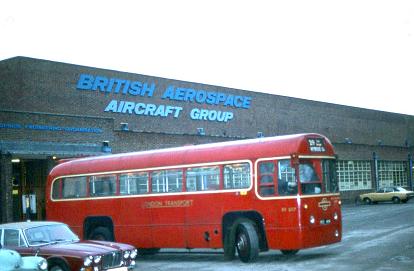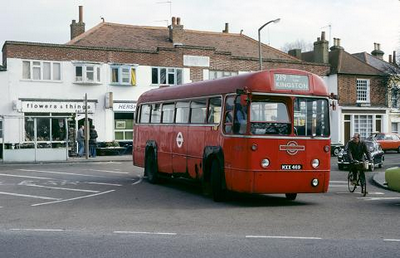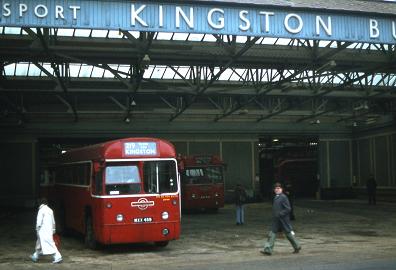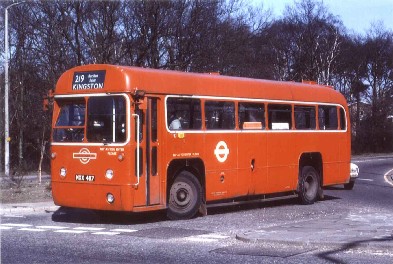The origins of the Kingston to Esher routes go back to
the very early single-deck operations around London, operated by
independents before the first world war. London Central
Omnibus Co started a new (unnumbered) route in November 1911,
worked by Leyland single-deckers from their Kingston Ceres Road
garage, between Kingston Market Place and Thames
Ditton Fountain. Three weeks later the route
was diverted and extended to run to Esher The Bear,
along what was then the main London to Portsmouth road. This
passed under the low bridge at Ditton Marsh - just on the
Kingston side of the (later) Scilly Isles, where the road goes
under the main line to Woking, Southampton and Portsmouth.
This is still the same today and was the main cause of so many
Kingston area routes being single-deck.
 On 1 Jan 13, the New Central (as it had
become) buses were leased to the General, who numbered the route as
79. In mid-1914, the New Central having been wound up, the
buses were repainted from blue and yellow into General
livery. As an aside, the other two routes operated by New
Central are still recognisable today (although indirectly) under
their 1913 numbers as 68 and 71. By 1915, the Ceres Road
garage was closed and operation was by Twickenham garage, with
periods at Putney when Twickenham was not available and settling
there in May 1921.
On 1 Jan 13, the New Central (as it had
become) buses were leased to the General, who numbered the route as
79. In mid-1914, the New Central having been wound up, the
buses were repainted from blue and yellow into General
livery. As an aside, the other two routes operated by New
Central are still recognisable today (although indirectly) under
their 1913 numbers as 68 and 71. By 1915, the Ceres Road
garage was closed and operation was by Twickenham garage, with
periods at Putney when Twickenham was not available and settling
there in May 1921.
RF507, later in the day to
become the last RF in scheduled LT service, also ran the last
working to Weybridge BAC Works (as it was still known to
LT, although by then BAC itself had morphed into British
Aerospace).
In August 1920, the route was extended at weekends to Church
Cobham, much later the route of the 215,
with Wednesday journeys added for a few weeks, then Thursday
journeys in late 1920, becoming daily journeys from May 1921.
June 1921 saw a further extension to West Byfleet Station via
Byfleet.
Meanwhile, new routes 112 and 115 were introduced in July
1921, the 112 from Kingston to Weybridge Station via Hersham
and the 115 from Kingston to Guildford via Cobham and Ripley.
These were also operated by Putney garage and they and
the extended 79 all used the 26-seat type-7 Bs that had
proved too heavy for the 111. Ken
Glazier uses the 112 as an example of the difficult terrain that
these 'country' services were venturing into.
Walton-on-Thames Urban District Council imposed an 8 mph speed
limit (in Lammas Lane) 'where the roadway touches the river' and
the General warned drivers of dangerous telegraph poles in the
vicinity and of narrow streets in Esher and Hersham; it imposed its
own 6 mph speed limit on Monument Hill, Weybridge.
 In January 1922, both 79 and 112 ceased to
operate, and the routes were combined into new route 79 running
from the new Kingston garage (K), following the 112 to Weybridge
Station before running via Byfleet to Woking, leaving Cobham served
by the 115 and Byfleet Road to await the introduction of
the 162B (later the 462) in March 1926. In
May 1923, Weybridge garage (WB) opened and joined Kingston in
working the route, which ran hourly. S-types replaced
the Bs later in 1922, and were in turn replaced by Ts in 1931.
In January 1922, both 79 and 112 ceased to
operate, and the routes were combined into new route 79 running
from the new Kingston garage (K), following the 112 to Weybridge
Station before running via Byfleet to Woking, leaving Cobham served
by the 115 and Byfleet Road to await the introduction of
the 162B (later the 462) in March 1926. In
May 1923, Weybridge garage (WB) opened and joined Kingston in
working the route, which ran hourly. S-types replaced
the Bs later in 1922, and were in turn replaced by Ts in 1931.
It is a week before the end of RF operation in
London. RF492 has just worked a short to Hersham Green and is
pulling off the stand - no longer used by the 264, which has already been withdrawn - to run
back via Esher to Kingston.
Photo ©
Dave Jones
In the renumbering of October 1934,
the 79 became the 219, still running to Woking with T-types
from K and WB (including the three experimental CB-class
single-deckers T1000-2, which spent their working lives at WB then
K on the 79/219). LT Scooters briefly made a scheduled
appearance from Kingston in 1937 when released from the
232, but in October that year the route
was cut back and reverted to T operation. The Woking to
Weybridge section was replaced by larger buses on Country Area
routes 437/A and 456 and the 219 diverted at Weybridge
to terminate at Weybridge Station forecourt. At the same
time, the 219 was supplemented in Weybridge by local service
219A between Weybridge
Grotto Road and the station, worked by buses from the
219.
January 1938 saw the introduction of the extension to Vickers
Works, with Mon-Fri peak journeys. Certain 219A
journeys were also extended there, including Saturdays. March
saw the formal reintroduction of Scooters, whilst the summer
timetables in May saw the beginnings of shared allocations with the
215 (Mon-Fri) and 218 (weekends) on Kingston to Hersham short
workings.
 After the outbreak of war,
four-bus Weybridge garage closed in December 1939 and the
219/A gained a purely LT allocation. The
219A lasted only until February 1941, when the 219
Vickers Works journeys became daily, including a new Sunday service
although this latter did not operate throughout the war.
After the outbreak of war,
four-bus Weybridge garage closed in December 1939 and the
219/A gained a purely LT allocation. The
219A lasted only until February 1941, when the 219
Vickers Works journeys became daily, including a new Sunday service
although this latter did not operate throughout the war.
In 1942/3, a number of Country Area buses, including 9 Qs at
Addlestone and two Ts at Leatherhead, were painted grey to reduce
their visibility when serving the Vickers
Works. From 1942 to 1945, the Central Area allocation
books refer to 'special vehicles' being used for Vickers Works
journeys and it is presumed that this refers to buses being painted
grey - can anyone confirm this?
On the last day of RF
service, RF512 sits in Kingston Bus Station. In the
background, RF522 carries blinds for the 216 - although that route
had lost its RFs three years earlier, some RFs worked the 216 on
the last day. The following day, an official tour by 3 RFs of
routes 218 and 219 included RF512.
Photo © John Parkin
Also in 1943, the Scooters were converted to perimeter seating
and authorised to carry 20 standing passengers, an arrangement that
continued until union objections brought the practice to a close
(earlier at Kingston than elsewhere) in October 1945.
The route was one of the recipients of new 14T12s in 1946, when
Kingston received the second batch (after Uxbridge for the 223). From 1946 to 1949, the official
allocation of Ts was shared with the 218
Mon-Sat; some Scooters were still scheduled on summer
Sundays. Kingston's Scooters were gone by 1949, from when the
joint allocation was switched to the 215
(which only shared the road as far as Esher), with Qs allocated
alongside Ts from 1950.
Kingston's pre-war Ts lasted until 1953 due to a weak bridge on
the 218, and the Qs also went that year, all swept away by the
effect of the deliveries of red RFs elsewhere on the network.
But Kingston's later Ts and newly arrived TDs had the
single-deck allocation to themselves until RFs arrived for the
216 in July 1959; the 219 allocation,
joint with both 215 and 218 from 1954, stayed TD until conversion
to RF in January 1960, on Kingston's largest intake of the
type.
 In 1966, operation of the 215 moved to
Norbiton, leaving just the 218 and 219 to share an allocation for
the rest of the life of the 219. It was not until September
1968 that the routes were converted to OMO RFs, the last
single-deck routes south of the river to be so converted and the
last except the 210 in 1970.
In 1966, operation of the 215 moved to
Norbiton, leaving just the 218 and 219 to share an allocation for
the rest of the life of the 219. It was not until September
1968 that the routes were converted to OMO RFs, the last
single-deck routes south of the river to be so converted and the
last except the 210 in 1970.
Reducing receipts led to the withdrawal of the Esher to
Weybridge section on Sunday mornings from January 1971, with the
exception of a single journey to BAC Works - renamed from Vickers
in 1964. Otherwise, the OMO RF route ran unchanged until 1979
except that the Weybridge Station terminus was moved on 22 Mar 77
from a reverse turn on the station forecourt to the top of Heath
Road.
During the last week of service, the RFs
carried posters in their windows advising of the change.
RF510, another of those that undertook the final tour on Saturday
31 Mar 1979, rounds the roundabout at Weybridge Station to stop on
the stand in Heath Road. This bus worked the last journey on
the 219 and was the last RF to leave Kingston in scheduled
service.
Photo © Steve Fennell
As related on the 218 page, the end
came on Friday 30 March 1979, when Norbiton's Leyland Nationals
took over the 218 and 219. That weekend saw the end of
weekend journeys to the BAC Works, but the reinstatement of
the Sunday morning Weybridge service, at the request of Surrey
County Council (changed days; Surrey now supports very few Sunday
buses).
October 1981 to September 1982 saw a short lived peak-hour
extension north of Kingston to serve Ham Beaufort Road,
but this was a final fling before the route disappeared completely
on 28 Jan 83, partly replaced by LCBS route 437. The final
journey was operated by LS148 driven by Steve Fennell.